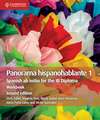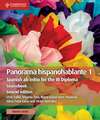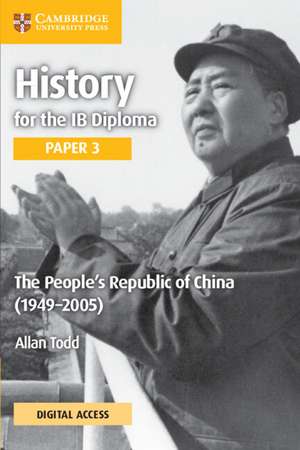History for the IB Diploma Paper 3 The People’s Republic of China (1949–2005) Coursebook with Digital Access (2 Years): IB Diploma
Autor Allan Todden Limba Engleză Mixed media product – 12 ian 2022
Din seria IB Diploma
-
 Preț: 73.77 lei
Preț: 73.77 lei - 23%
 Preț: 1322.24 lei
Preț: 1322.24 lei -
 Preț: 412.32 lei
Preț: 412.32 lei - 9%
 Preț: 858.69 lei
Preț: 858.69 lei -
 Preț: 242.67 lei
Preț: 242.67 lei -
 Preț: 242.19 lei
Preț: 242.19 lei -
 Preț: 79.14 lei
Preț: 79.14 lei -
 Preț: 367.75 lei
Preț: 367.75 lei -
 Preț: 368.95 lei
Preț: 368.95 lei -
 Preț: 158.81 lei
Preț: 158.81 lei -
 Preț: 167.15 lei
Preț: 167.15 lei -
 Preț: 221.39 lei
Preț: 221.39 lei -
 Preț: 348.79 lei
Preț: 348.79 lei -
 Preț: 114.53 lei
Preț: 114.53 lei -
 Preț: 157.63 lei
Preț: 157.63 lei -
 Preț: 387.85 lei
Preț: 387.85 lei -
 Preț: 183.54 lei
Preț: 183.54 lei -
 Preț: 434.47 lei
Preț: 434.47 lei -
 Preț: 243.64 lei
Preț: 243.64 lei - 23%
 Preț: 1215.91 lei
Preț: 1215.91 lei -
 Preț: 381.77 lei
Preț: 381.77 lei -
 Preț: 156.67 lei
Preț: 156.67 lei -
 Preț: 255.23 lei
Preț: 255.23 lei -
 Preț: 407.55 lei
Preț: 407.55 lei -
 Preț: 157.14 lei
Preț: 157.14 lei - 8%
 Preț: 505.53 lei
Preț: 505.53 lei -
 Preț: 167.78 lei
Preț: 167.78 lei -
 Preț: 386.09 lei
Preț: 386.09 lei - 16%
 Preț: 797.99 lei
Preț: 797.99 lei -
 Preț: 158.11 lei
Preț: 158.11 lei - 9%
 Preț: 858.26 lei
Preț: 858.26 lei -
 Preț: 242.43 lei
Preț: 242.43 lei -
 Preț: 114.77 lei
Preț: 114.77 lei - 8%
 Preț: 424.77 lei
Preț: 424.77 lei - 23%
 Preț: 1288.91 lei
Preț: 1288.91 lei -
 Preț: 181.92 lei
Preț: 181.92 lei - 9%
 Preț: 893.93 lei
Preț: 893.93 lei -
 Preț: 347.74 lei
Preț: 347.74 lei -
 Preț: 73.54 lei
Preț: 73.54 lei -
 Preț: 290.62 lei
Preț: 290.62 lei -
 Preț: 79.14 lei
Preț: 79.14 lei -
 Preț: 487.74 lei
Preț: 487.74 lei - 19%
 Preț: 426.58 lei
Preț: 426.58 lei -
 Preț: 330.34 lei
Preț: 330.34 lei -
 Preț: 368.67 lei
Preț: 368.67 lei -
 Preț: 242.69 lei
Preț: 242.69 lei -
 Preț: 242.22 lei
Preț: 242.22 lei - 8%
 Preț: 476.66 lei
Preț: 476.66 lei -
 Preț: 411.37 lei
Preț: 411.37 lei -
 Preț: 168.05 lei
Preț: 168.05 lei
Preț: 296.11 lei
Nou
Puncte Express: 444
Preț estimativ în valută:
56.67€ • 58.94$ • 46.78£
56.67€ • 58.94$ • 46.78£
Carte disponibilă
Livrare economică 24 martie-07 aprilie
Preluare comenzi: 021 569.72.76
Specificații
ISBN-13: 9781009190183
ISBN-10: 1009190180
Pagini: 396
Dimensiuni: 152 x 228 x 18 mm
Greutate: 0.54 kg
Ediția:Nouă
Editura: Cambridge University Press
Colecția Cambridge University Press
Seria IB Diploma
Locul publicării:Cambridge, United Kingdom
ISBN-10: 1009190180
Pagini: 396
Dimensiuni: 152 x 228 x 18 mm
Greutate: 0.54 kg
Ediția:Nouă
Editura: Cambridge University Press
Colecția Cambridge University Press
Seria IB Diploma
Locul publicării:Cambridge, United Kingdom
Cuprins
1. Introduction; Chapter 2. The consolidation of the communist state, 1949-55: 2.1. How did the Communists establish their political rule in the years 1949-55?; 2.2. What were the main economic policies during the period 1949-55?; 2.3. What social reforms did the Communists implement during the years 1949-55?; Chapter 3. Mao's Revolution, 1956-61: 3.1. Why was the Hundred Flowers' Campaign launched?; 3.2. What were the main features of the 'Great Leap Forward'?; 3.3. What were the immediate consequences of the 'Great Leap Forward'?; Chapter 4. Power Struggles and the Cultural Revolution, 1962-71: 4.1. How did Mao begin to re-establish his political leadership after 1961?; 4.2. What were the main features of the Cultural Revolution?; 4.3. Why was there a new power struggle during 1970-71?; Chapter 5. Foreign policy, 1949-1976: 5.1. What were the main features of Communist China's early foreign policy?; 5.2. Why did a serious rift develop between China and the Soviet Union in the 1960s?; 5.3. What was the significance of Communist China's rapprochement with the USA in the 1970s?; Chapter 6. The struggle for power, 1972-82: 6.1. Why were there tensions within the CCP from 1972-75?; 6.2. What was Mao's legacy?; 6.3. What were the main stages of the power struggle 1976–82?; Chapter 7. Deng's Economic Revolution (1976-1989): 7.1. What economic policies were followed by Hua in the period 1976–78?; 7.2. What were the main features of Deng's 'Revolution', 1979–89?; 7.3. How successful were Deng's economic reforms?; Chapter 8. Political Developments under Deng, 1976-89: 8.1. What was Deng's political approach in the period 1976–79?; 8.2. Why did political unrest re-emerge in the period 1980–87?; 8.3. What led to the Tiananmen Square Massacre of June 1989?; Chapter 9. Developments in China, 1989-2005: 9.1. How did China's politics change after 1989?; 9.2. What were the main economic developments after 1989?; 9.3. How far have China's leaders created a 'Harmonious Society'?; 9.4. How did China's relations with the rest of the world develop after 1989?; 9.5. To what extent was China still communist by 2005?; Chapter 10. Exam practice; Further Reading; Index.
Descriere
Comprehensive books to support study of History for the IB Diploma Paper 3, revised for first assessment in 2017.
